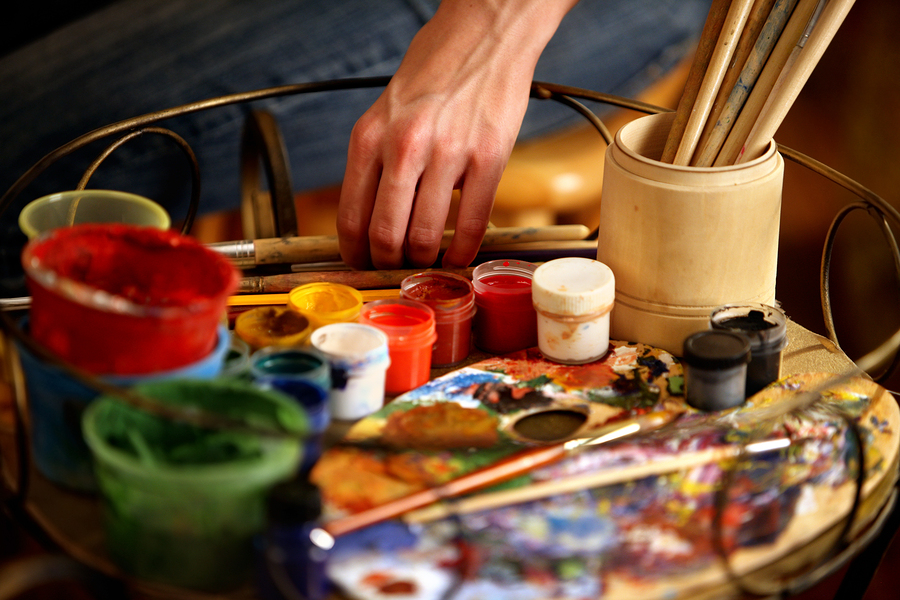When you need a material that blocks out light, duvetyne is perfect. It’s the material you often see in theaters that forms the background at the back of the stage. It’s also the material that forms a stage’s skirting. It’s used as a backdrop in photo studios.
This fabric does block light, but it also cuts reflections. It can hide hands or arms when you’re shooting an advertisement where you want the focus to be on the product and not who is holding it. It is a soft, cotton fabric that’s bought by the yard, but you can get it in full rolls.
Duvetyne is affordable. It’s also flame retardant, which is important when there is lighting equipment nearby. As the fire protection is applied to the material, you need to be careful about getting it wet. That’s one thing to keep in mind when you’re thinking about painting duvetyne.
What if you need to paint it? Look into fabric sprays that add a new coating of fire protection. Test a small area to make sure it doesn’t affect the paint you’re using. Chicago Canvas & Supply has a few tips to help you create gorgeous decorative backgrounds on duvetyne.
What Are the Best Paints to Use on Duvetyne?
Which paint should you use to create your background? Acrylic paints are a popular choice, but you have to consider lighting. Paints fade when exposed to constant bright lighting or sunlight. You need to search for UV/fade resistant paints.
Fabric paints are softer in feel. They’re also easier to apply to fabrics for that reason. If you opt to use acrylic paints, you can mix them with gloss or fabric mediums for easier application and to cut down on reflectiveness.
What Techniques Are Used to Paint Decorative Backdrops?
You have two ways to go when painting backgrounds on fabric. You can paint by hand with brushes, sponges, and rollers, or you can use airbrushing.
Supplies Needed for Hand Painted Backdrops
If you want to paint by hand, have brushes in a wide variety of sizes. A roller is good for priming your duvetyne. Sponges are great for work that needs to be hazy like clouds.
Keep a bucket handy for clean up. Acrylic paints wash in warm soapy water. You should have disposable gloves to keep your hands from getting covered in paint. Damp towels will help with clean-up if any paint splatters in unprotected areas.
Fans set in the room help speed up drying times. You may want to have some floor fans available for this reason.
Try Airbrushing
Airbrushing is handy when you want to paint a large section of fabric. It’s done by creating the overall sketch and breaking it down into a grid and then using that grid as a template for painting the final product on the large portion of duvetyne. The benefit to airbrushing is that you can hang the duvetyne and paint vertically rather than stretching the fabric out on the floor.
If you decide to airbrush, you want to weigh down the bottom of the duvetyne after hanging it. This keeps the fabric stiff while you’re using the airbrush.
Prepare Your Surface First
Before you paint your background, use gesso as your primer. Gesso is typically found in white, but you can get it in black, clear, and a rainbow of colors. It is available in sprays or brush-on forms. It creates a surface that is smooth but has a slightly sandy feel that keeps the paint from absorbing into the canvas material. It also helps stiffen the material, which can be helpful when you’re going to be hanging the background.
As an alternative, you could use interior paint colors for your backdrop. PVA primer is the white primer you use in your home. This is ideal if you’re starting with white duvetyne instead of black.
Make Cleaning Up Easy to Handle
To ensure you keep the flooring from paint spills and splatters, purchase a large heavy-duty canvas drop cloth. When you’re done painting, leave your backdrop to dry while you wash brushes and other equipment used while you painted. Once the paint on the duvetyne is dry, move it and fold up the drop cloth for another use.
At Chicago Canvas & Supply, we offer duvetyne in several colors. Choose black if that’s ideal for your production, but know that you can also pick grey, royal blue, silver, white, or wine. It’s easy to create stunning backdrops when you trust in us to help you find the right size and weight. Need help? Message us through our live chat or call (773) 478-5700 to ask an expert.





